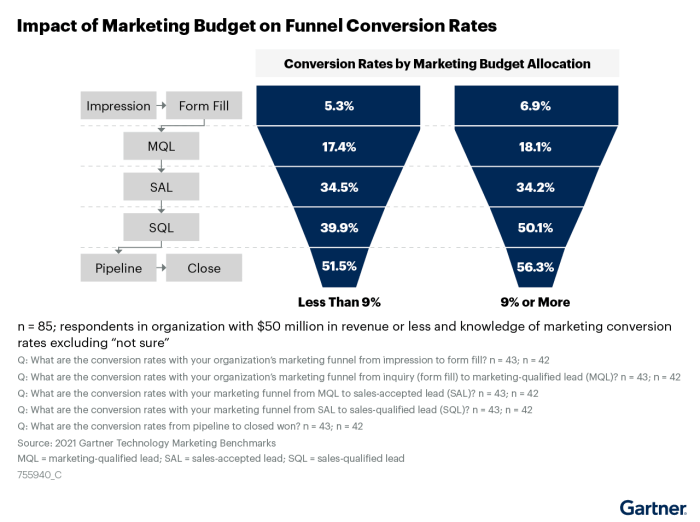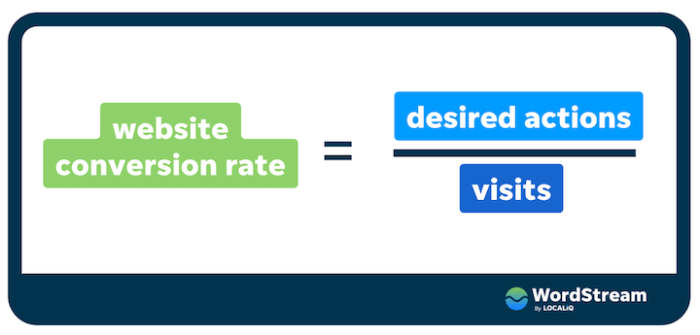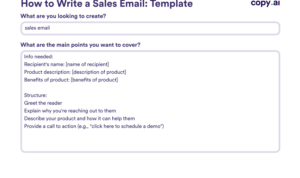With Website Conversion Rates at the forefront, get ready to dive into the world of online success and optimization. From tracking different conversion rates to implementing winning strategies, this topic will unveil the secrets to boosting your website’s performance.
Definition of Website Conversion Rates
Website conversion rates are a key metric used by businesses to measure the effectiveness of their online presence. It refers to the percentage of website visitors who take a desired action, such as making a purchase, signing up for a newsletter, or requesting more information. High conversion rates indicate that a website is successfully engaging visitors and turning them into customers, while low conversion rates may signal areas for improvement in the user experience or marketing strategies.
Types of Website Conversion Rates
- 1. Sales Conversion Rate: This measures the percentage of website visitors who make a purchase.
- 2. Lead Generation Conversion Rate: This tracks the percentage of visitors who fill out a form or provide contact information.
- 3. Click-Through Rate: This calculates the percentage of visitors who click on a specific link or call-to-action.
- 4. Email Signup Conversion Rate: This measures the percentage of visitors who subscribe to an email list.
Calculating Website Conversion Rates
To calculate the conversion rate, divide the number of conversions by the total number of visitors and multiply by 100. The formula is:
Conversion Rate = (Conversions / Total Visitors) x 100
This metric is essential for analyzing the performance of online marketing campaigns, identifying areas for improvement, and optimizing website content to increase conversions.
Factors Influencing Website Conversion Rates

When it comes to website conversion rates, there are several key factors that can impact how successful your site is at turning visitors into customers. Factors such as website design, user experience, call-to-action buttons, loading speed, and marketing strategies all play a role in determining the conversion rate of a website.
Website Design and User Experience
The design of your website and the overall user experience are crucial in determining whether visitors will convert into customers. A clean, visually appealing design that is easy to navigate can encourage users to explore your site further and ultimately make a purchase.
Call-to-Action Buttons
Effective call-to-action buttons can make a significant difference in conversion rates. Clear, compelling calls-to-action that stand out on the page and prompt users to take action can lead to higher conversion rates.
Loading Speed, Website Conversion Rates
The loading speed of your website also plays a role in conversion rates. Slow loading times can frustrate users and lead them to abandon your site before completing a desired action. Ensuring fast loading speeds can help improve conversion rates.
Marketing Strategies
Different marketing strategies, such as , PPC, social media, and email marketing, can all influence website conversion rates. By targeting the right audience with the right message at the right time, these strategies can help drive more conversions on your website.
Successful Strategies Examples
One successful strategy to improve website conversion rates is A/B testing different elements of your website, such as call-to-action buttons or page layouts, to see which variations perform better. Another effective strategy is to personalize the user experience based on visitor behavior and preferences, increasing the likelihood of conversion.
Importance of Monitoring and Analyzing Conversion Rates

Monitoring and analyzing conversion rates regularly is crucial for businesses looking to optimize their websites and increase their online success. By keeping a close eye on conversion rates, companies can gain valuable insights into customer behavior, identify areas for improvement, and make informed decisions to enhance their overall digital strategy.
Utilizing Data for Informed Decisions
Analyzing conversion rates provides businesses with concrete data on how effective their website is at turning visitors into customers. By tracking key metrics such as bounce rates, click-through rates, and conversion funnels, companies can pinpoint where users may be dropping off or experiencing friction in the conversion process. This data allows businesses to make data-driven decisions to optimize their website design, content, and user experience to ultimately drive more conversions.
- By analyzing conversion rates, businesses can identify which marketing campaigns or channels are driving the most valuable traffic and adjust their strategies accordingly.
- Conversion rate analysis can also help businesses understand customer preferences, pain points, and behavior patterns, allowing them to tailor their offerings to meet customer needs more effectively.
- Utilizing data from conversion rate analysis can lead to higher ROI on marketing efforts and improved overall website performance.
Tools for Tracking and Analyzing Conversion Rates
There are several tools and software available that can help businesses track and analyze website conversion rates effectively. Some popular options include:
- Google Analytics: A free tool that provides in-depth insights into website traffic, user behavior, and conversion rates.
- Hotjar: Allows businesses to visualize user behavior on their website through heatmaps, session recordings, and feedback polls.
- Crazy Egg: Provides heatmaps, scroll maps, and click reports to help businesses understand how users interact with their website.
- Optimizely: A/B testing platform that enables businesses to test different variations of their website to optimize for higher conversion rates.
Strategies for Improving Website Conversion Rates
Improving website conversion rates is crucial for businesses looking to maximize their online presence and drive more sales. By implementing effective strategies, companies can enhance user experience, increase engagement, and ultimately boost their conversion rates.
Utilize Clear Call-to-Actions
One of the key strategies for improving website conversion rates is to use clear and compelling call-to-actions (CTAs) throughout the website. CTAs prompt visitors to take specific actions, such as signing up for a newsletter, requesting a quote, or making a purchase. By making CTAs stand out with contrasting colors, strategic placement, and persuasive copy, businesses can guide users towards conversion.
Optimize Website Speed and Performance
Another important strategy is to optimize website speed and performance. Slow-loading pages can lead to high bounce rates and deter users from completing desired actions. By optimizing images, reducing server response time, and leveraging caching techniques, businesses can create a faster and more seamless user experience, increasing the likelihood of conversions.
Implement A/B Testing
A/B testing is a powerful technique that involves creating two versions of a webpage (A and B) with slight variations and testing them to see which performs better in terms of conversion rates. By analyzing user behavior and preferences through A/B testing, businesses can make data-driven decisions to optimize their website for higher conversions.
Personalize User Experience
Personalizing the user experience based on individual preferences and behavior can also lead to improved conversion rates. By utilizing data analytics and segmentation, businesses can deliver customized content, product recommendations, and offers that resonate with users, increasing the likelihood of conversion.
Case Study: Company X
Company X implemented a clear and concise CTA strategy on their product pages, resulting in a 20% increase in conversion rates. By simplifying the checkout process and using engaging CTAs, they were able to guide users towards making a purchase more effectively, leading to a significant improvement in their overall conversion rates.





